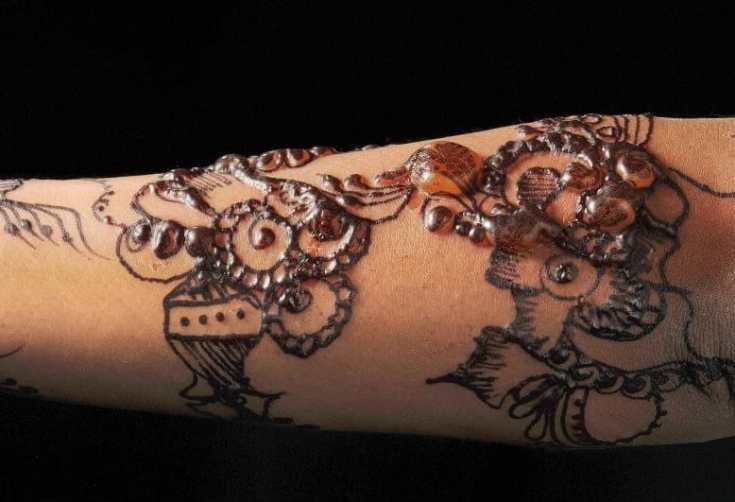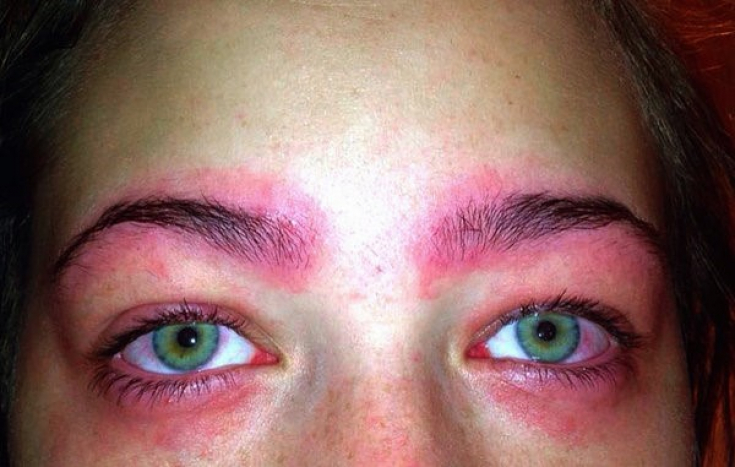The popularity of temporary tattoos has increased in recent years, probably due to a change in attitudes in society, with tattoos in general becoming more widespread. This growing craze for body art has led to an increase in demand for henna tattoos. In addition, henna began to be used for brow coloring.
However, is it safe to use henna? Read on estet-portal.com what complications can await after applying henna, and how a doctor can treat patients with side effects .
- Why Henna Tattoos Can Be Dangerous
- Differences between henna and "black henna"
- What is the danger of paraphenylenediamine
- Complications after using "black henna"
- How to treat complications after a henna tattoo
Why henna tattoos can be dangerous
At first glance, henna tattooing is a completely positive phenomenon that allows people to get a tattoo for a short time. However, with the popularization of this technique, intensification of adverse reactions to henna is associated.

"Black henna" used for temporary tattoos and eyebrow tinting may contain irritant dyes such as paraphenylenediamine (PPD) at concentrations that may cause blisters, painful skin burns and scarring.
A survey conducted by the British Skin Foundation in 2015 showed that 40% of dermatologists (244 respondents) experienced negative skin reactions to temporary black henna tattoos.
Read also: Uneasy touching: why contact dermatitis develops
Differences between henna and "black henna"
Henna is a natural pigment obtained from the leaves of Lawsonia inermis, a small tree native to North Africa, South Asia and northern Australia. The active ingredient lawesone is released from the leaves during the drying process before further processing to make a henna paste. When applied, henna paste concentrates in the epidermis of the skin and turns orange when removed. It darkens to a reddish brown after two to three days, and it is in this form that henna has been used to create body art since ancient times.
On the other hand, "black henna" is a synthetic pigment made by mixing chemicals and dyes with naturally occurring henna. Its compound chemicals are chosen to produce dark, fast-drying inks. It is the dangerous paraphenylenediamine (PPD) that is often added to black henna to improve color and speed up drying.
Research on the causes and age-related characteristics of the development of allergic dermatitis
What is the danger of paraphenylenediamine
In the 1930s, the practice of coloring of the eyebrows and eyelashes with PPD dyes was common. Following reports of severe adverse reactions and blindness associated with the use of PPD colorants, the US federal government has created a legal framework to govern the cosmetics industry.
A causal relationship has finally been established between PPD and allergic contact dermatitis.
The activity of PPD as an allergen depends on its concentration and duration of direct exposure.
PPD is now known to be a potent T cell stimulator. Once activated by an antigen, these cells release inflammatory cytokines and activate other subgroups of lymphocytes, resulting in a delayed type IV hypersensitivity reaction.
Read the most interesting articles in Telegram!
Complications after using "black henna"
Skin reactions to black henna are usually type IV hypersensitivity reactions mediated by T-lymphocytes. These reactions traditionally occur within 10 days after exposure to the allergen. However, pre-sensitization may precipitate the onset of symptoms.
The first signs of a reaction to a henna tattoo may include irresistible itching or burning, the appearance of an erythematous-eczematous rash.

After sensitization, patients are at risk of developing more extensive allergic reactions, including anaphylaxis, if subsequently exposed to PPD. The widespread use of PPD in hair and textile dyes means that sensitized patients may develop allergic contact dermatitis to natural rubber latex, azo dyes, thiurams, para-aminosalicylic acid, and benzocaine.
How to treat complications after a henna tattoo
In the acute phase, treatment is aimed at turning off the inflammatory process and controlling symptoms. Topical are corticosteroids, the activity of which is selected depending on the site of the lesion. For widespread reactions, systemic steroids.
In the event of anaphylaxis, adrenaline is injected intramuscularly into the henna tattoo field with mandatory hospitalization for observation.
Once the acute phase has subsided, scarring can complicate the recovery phase.
Treatment of post-inflammatory scars is a major challenge. There are many approaches that can be used with varying degrees of success.
Conservative treatments include the use of occlusive dressings and compressions.
- The anti-keloid effects of occlusion are believed to be due to a combination of occlusion and hydration.
- Compression therapy involves the use of pressure to flatten scars. It is believed that the involved mechanoreceptors activate cellular apoptosis and also inhibit fibroblast proliferation.
Injections of corticosteroids around the site of the lesion are the mainstay of treatment and reduce scarring by inhibiting the synthesis of collagen, glycosaminoglycan, inflammatory mediators, and fibroblast proliferation.
More invasive treatments include cryotherapy and surgical excision. Cryotherapy affects the microvasculature, causing apoptosis through the formation of intracellular crystals and anoxia.
Finally, non-ablative and ablative laser techniques have also been used to treat hypertrophic and keloid scars, with varying degrees of success
Temporary black henna tattoos can pose significant health risks. Adulteration of natural henna with unregistered dyes, including the prohibited compound PPD, exposes the user to the risk of developing allergic contact dermatitis.
Read also: Features of the modern treatment of atopic dermatitis: modern methods







Add a comment